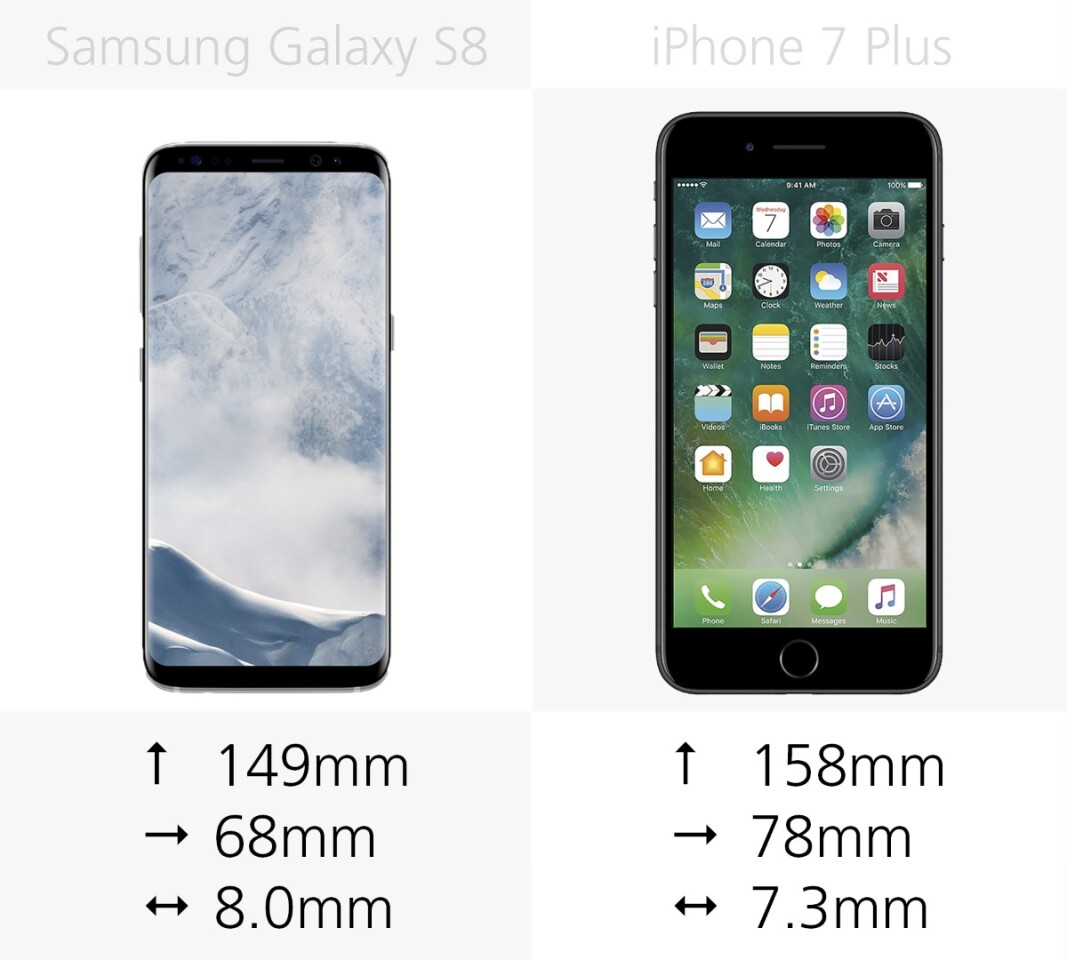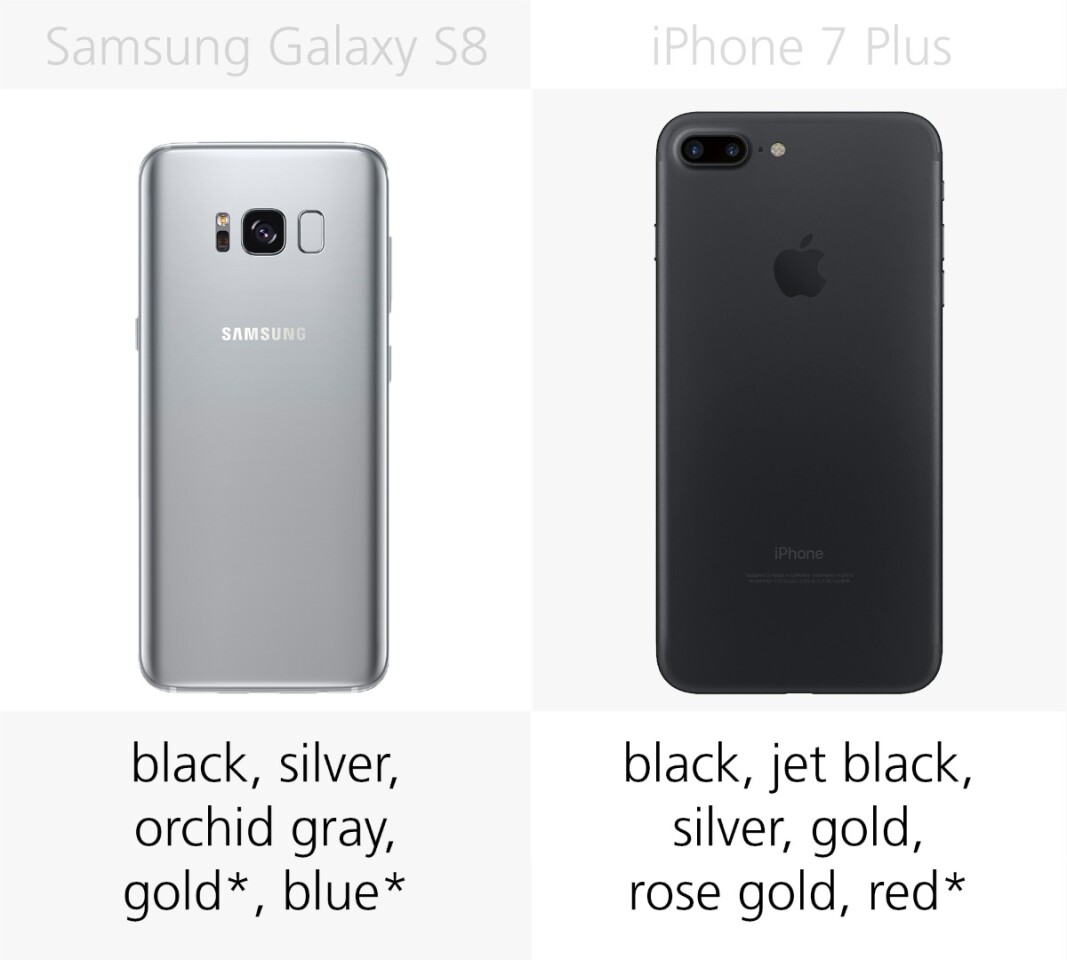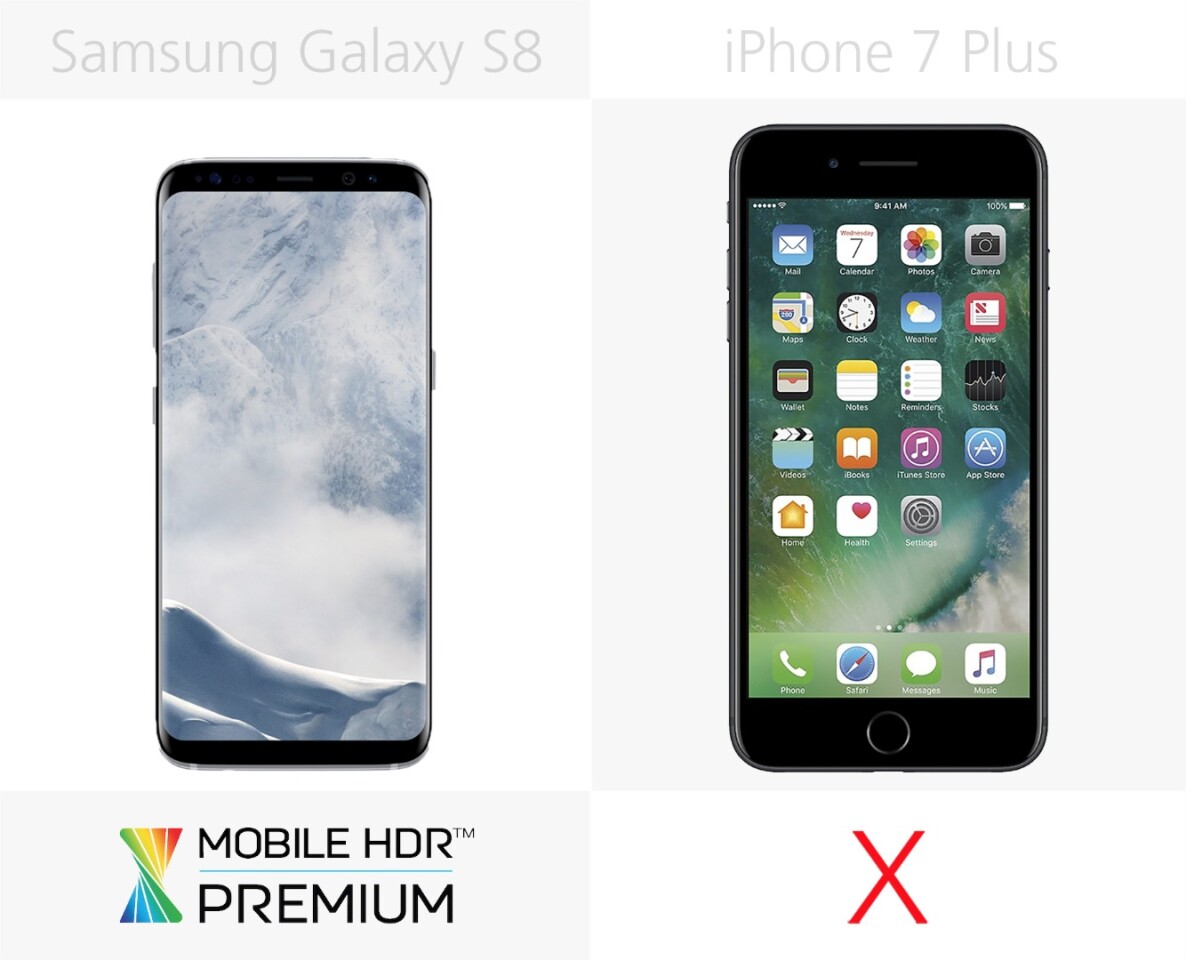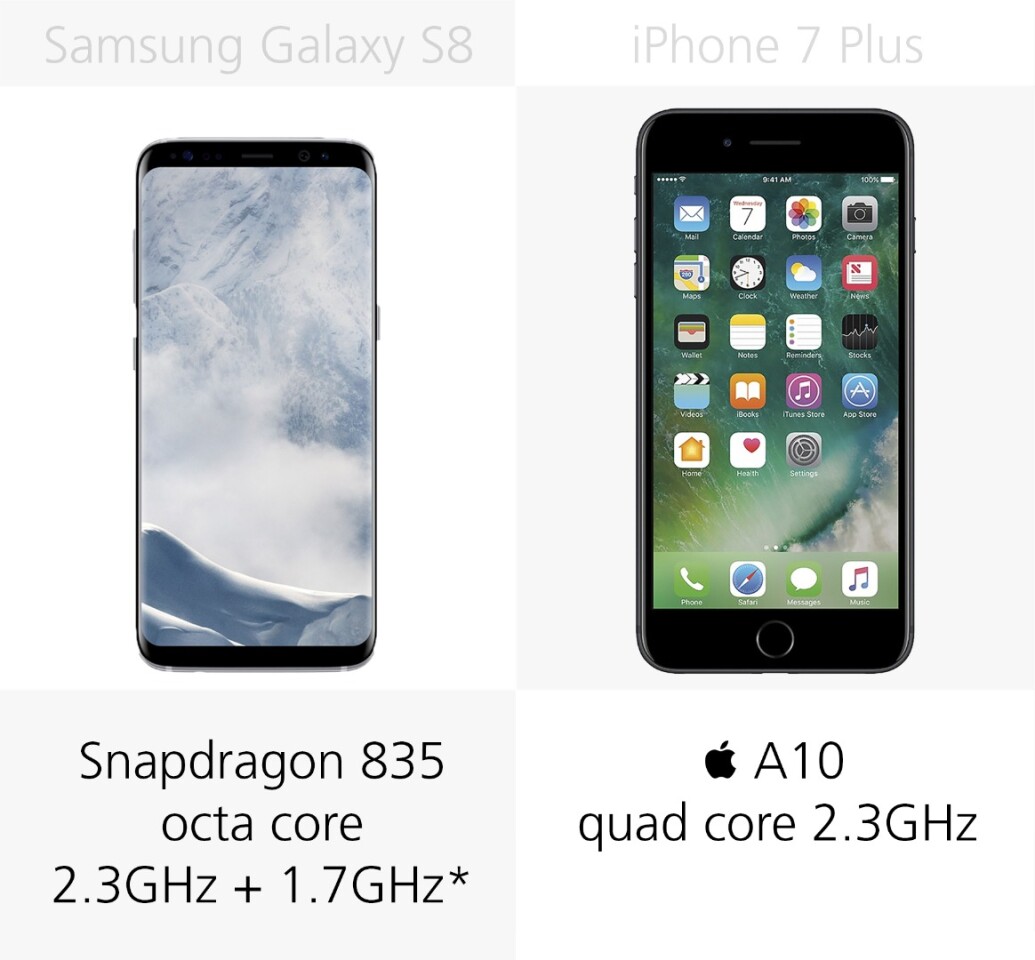The smaller of Samsung's S8 series flagships is quite comparable to Apple's latest phablet. Here's how the specs and features of the Samsung Galaxy S8 match up with those of the iPhone 7 Plus.
Size

The iPhone 7 Plus is about 6-percent taller and 13-percent wider, but the Galaxy S8 is the thicker of the two (by less than a millimeter).
Weight

The hefty iPhone 7 Plus is nearly 18-percent heavier (30 grams) than the S8.
Build

Both makers stick with tried-and-true builds. The Galaxy S8, like its previous generation, has a glass back and a thin aluminum frame. The iPhone 7 Plus has a an aluminum unibody like several iPhones before it.
Colors

There are several color options for these phones, but not all variants are available everywhere. In the US, the S8 is currently available in black, silver and orchid gray, and the red iPhone is a special edition.
Water resistance

The S8 has a slightly higher water resistance rating than the iPhone 7 Plus, but either one should be able to withstand splashes and quick shallow dips.
Display size

Samsung's so-called Infinity Display is the killer feature of the S8 series. The expansive display stretches around the phone's edges and covers nearly the entire front of the phone. So even though it's a smaller phone, the S8 has a 2-percent bigger display.
Display resolution

The QHD+ resolution on the S8 display beats the 401 PPI display on the iPhone.
Display type

These two makers fall on opposite sides of the AMOLED/IPS fence.
HDR display

The S8 flagships are the first phones to receive the Mobile HDR Premium designation from the UHD Alliance, which guarantees adherence to certain standards and means that the S8 supports HDR content.
Curved display

You may not be able to tell from pictures taken straight-on, but the Galaxy S8 takes after Samsung's "Edge" style phones from years past. The curved displays wrap around the side edges of the phone.
Pressure-sensitive display

Only the iPhone has 3D Touch pressure sensitivity built into its display. That means you can navigate differently depending on how long and hard you tap the screen.
Home button

The S8 has an onscreen home button with some pressure-sensitivity built into it (but not into the rest of the display). The iPhone 7 Plus has an offscreen solid-state home button below the display.
Fingerprint sensor

Samsung has moved the fingerprint sensor to the back of the phone, to the right of the camera lens. On the iPhone, the fingerprint sensor is embedded into the home button.
Face recognition

The S8 has a face scanning feature that lets you unlock your phone just by looking at it, but it may not be the most secure option.
Iris scanning

The S8 also has an iris scanner, a feature introduced on the ill-fated Note 7 that seems to have been much improved since then.
Processor

The two premium phones have similarly capable top-of-the-line processors. In the US and other markets, the S8 uses the latest Snapdragon 835 chip (elsewhere, it includes Samsung's Exynos-branded chip). The iPhone uses Apple's own A10 processor.
RAM

The S8 packs in one more gigabyte of RAM than the iPhone, but it's not quite an apples-to-apples comparison: The two operating systems use memory differently.
Storage

The S8 is available in one 64 GB size, while the iPhone comes in three sizes ranging from 32 GB to 256 GB (though the 32 GB size is not available in the glossy jet black color variant).
MicroSD

If you're worried about space, however, Samsung still has you covered with a microSD slot for expandable storage.
Headphone jack

Apple axed the traditional headphone jack, but it's still present on the S8 series.
Bundled headphones

Samsung includes a pair of wired AKG headphones (which retail separately for US$99) while Apple includes a set of wired earpods with a Lightning port. Apple also includes a headphone-jack-to-Lightning adapter in case you have an older pair you want to use.
Battery

The two phones have very similar battery capacities, but size alone is only one indication of overall battery life. We'll put the S8 to the test in our full-length review.
Wireless charging

The Galaxy S8 supports wireless charging with a compatible charging pad (sold separately), and even a degree of fast wireless charging.
Fast charging

The Galaxy S8 supports Qualcomm Quick Charge, but iPhone charging is not similarly speedy.
Camera megapixels

The two rear-facing cameras are both 12 MP, but the Samsung's front camera sneaks in an extra megapixel for sharper selfies.
Camera aperture (rear)

The S8 camera also has a slightly larger aperture, which could mean a small advantage for low-light shooting.
Dual-lens camera

The iPhone 7 Plus' dual-lens rear camera could be one of its major advantages. The camera uses one standard and one telephoto lens that lets the iPhone camera to achieve 2x optical zoom and 10x digital zoom, as well as depth-of-field effects in Portrait Mode.
Optical image stabilization (OIS)

Both cameras have OIS to combat image blur brought about by shaky hands.
Mobile payments

The S8's Samsung Pay has an advantage over Apple Pay – in addition to being read by NFC scanners, it can also imitate a magnetic strip card, so it can be accepted by more merchants.
Voice assistant

The iPhone has Siri, while the S8 has both Google Assistant and Samsung's all-new Bixby (and a dedicated Bixby activation button on the side of the phone). Unfortunately, we're not sure when Bixby is going to be fully operational, as its voice-related features are disabled at launch.
VR headset

The S8 supports the Samsung Gear VR headset, but the iPhone doesn't support mobile VR beyond basic Google Cardboard (and similar) functionality.
Desktop PC dock

With Samsung's DeX dock (sold separately) you can use your S8 to power a desktop PC computing experience using a separate keyboard, monitor and mouse.
Release

The iPhone 7 Plus is a 2016 flagship released late last year, while the Samsung S8 series is just starting to hit shelves.
Software

The S8 runs Android Nougat with Samsung's TouchWiz UI layered on top. The iPhone 7 Plus runs Apple's current mobile OS, iOS 10.
Starting price (full retail)

Pricing for the Samsung Galaxy S8 fluctuates depending on carrier and payment plan, but count on paying at least $720 when all is said and done. That makes it just a bit cheaper than Apple's most expensive iPhone, which starts at $769.
For the kind of information you can't get from a spec sheet, check out our review of the iPhone 7 Plus, as well as our hands-on impressions of the Samsung Galaxy S8. Stay tuned: We'll post a full-length review of the S8 series in the near future.







































